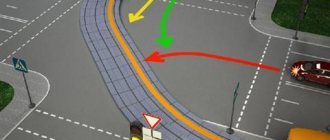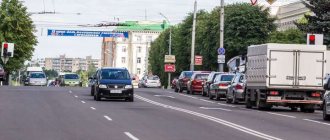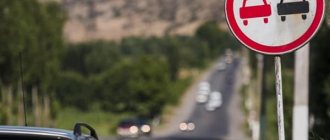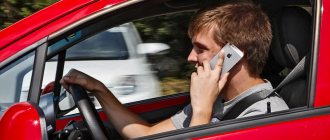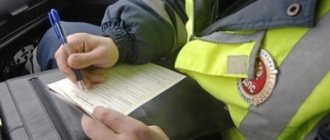Despite the fact that all drivers can make a U-turn, it can be difficult to do it correctly at various types of intersections without violating traffic rules, since many nuances need to be taken into account. Performing this maneuver requires the driver not only to be attentive, but also to know which type of transport has priority on those parts of the road that are or are not regulated by traffic lights.
All features must be taken into account not so much for passing the exam in order to obtain a driving license, but for daily driving, so as not to provoke emergency situations and accidents, deprivation of rights and the issuance of a fine.
What traffic rules say about the 2021 U-turn rules
In the set of traffic rules, paragraph No. 8 is devoted to a description of the correct turn. General rules for drivers to prevent accidents:
- Before performing such a maneuver, you need to give a signal using a light indicator on the side in which the car is turning. If this is not possible, you need to give a signal with your hand, bending it at the elbow at a right angle.
- The signal cannot be given at the moment of the turn: it must be done in advance, and completed immediately after it is completed.
- When turning left or right, the driver needs to take the extreme position on the road. This does not apply only to those cases when you need to turn when entering an intersection.
Rules for turning at intersections - The turn must be carried out so that the car does not end up on the side of oncoming traffic.
- If there is a braking lane, then you only need to reduce speed before the maneuver.
- According to traffic regulations, you cannot turn in places of increased danger: pedestrian crossings, tunnels, bridges, stops, railway crossings, places with limited or poor visibility of the roadway.
- If the vehicle cannot turn according to the rules due to its size or other reasons, deviation from the rules is allowed. However, this should not cause any interference or danger to other vehicles.
How to correctly make a U-turn at an intersection during the exam
In order to successfully pass the license exam, it is enough to take into account several nuances and follow the learned rules. The main ones regarding turns:
- When turning right/left, you must first take an extreme position on the road, which is intended for movement in that direction. This does not apply to an intersection with a roundabout.
- When turning right, the vehicle should be as close as possible to the right edge of the road.
- If you are making a left turn, you can sometimes move into the lane needed for oncoming traffic, although this is prohibited by the rules in most cases.
- Most often, turning rules are violated in the winter season. The main reason is the road surface hidden under the snow and the formation of ruts.
It should be taken into account that the width of the road is not limited by the knurled section. We must not forget to take the extreme position to perform the maneuver. - You cannot make a U-turn at a zebra crossing: even running into this part of the road can lead to failure of the exam.
- You cannot turn around outside an intersection if there is no visibility of 100 meters or more.
- Be sure to turn on the required direction indicators when performing maneuvers.
Schemes and rules for making a U-turn at various intersections
The rules for turning around depend on the type of intersection at which the maneuver is being made. At the same time, some types of transport have advantages in traffic, which also need to be taken into account when making turns.
Regulated
At an intersection that is regulated by a traffic light, this maneuver is easiest to perform, since the driver only needs to let the oncoming traffic pass. Traffic on the right and left will be stopped by a traffic light. The driver is required to:
- compliance with the direction of movement according to the markings;
- making sure that there is no sign in front of the intersection that prohibits the maneuver.
Turning at a signalized intersection
Equivalent
An equivalent intersection has three main features: it is not regulated, there are no priority signs, and the surface on the intersecting roads is the same. To turn around correctly in such a place, the driver needs to know who is “in charge”:
- a tram has an advantage over a car, regardless of where it is going;
- Drivers of trackless vehicles are required to give way to vehicles moving on the right;
- if there is no vehicle on the right, you can start moving.
Turning at an equivalent intersection
T-shaped
Almost any passenger vehicle can turn around at this type of intersection. An exception may be large vehicles whose turning radius is too large. To perform this action, you need to find the safest place: here you cannot drive in reverse (fine - 500 rubles) and perform a series of turns. General rules for safe driving:
- you must follow the “Main Road”, “Stop” and “Give Way” signs;
- if there are no signs at the intersection, the main rule for drivers is “Interference on the right”;
- When driving, turning on the direction indicators is mandatory;
- when the road is narrow, movement along the far path is required, along the near path - if the road is wide.
Turning at a T-junction
With tram tracks
In accordance with traffic regulations, rail transport has an advantage over other types. The first one gives way to passenger vehicles only if he himself is driving on an adjacent road, and the car is driving on the main road.
Remember! If there is a traffic light at the intersection that regulates the movement of trams and cars, the first will be a priority.
When the light for the car is green and the light for the tram is red, the latter is stationary. However, he can start moving towards the arrow that was turned on along with the red traffic light sign - and this is a violation.
If there is no traffic light at the intersection, then the tram will also have priority.
With dividing strip
On roads with this type of marking, there are 2 ways to turn: when the lane reaches or crosses an intersection:
- The first case requires performing a maneuver only along a small trajectory, since there is usually enough space on such roads. Entering the intersection of roads is strictly prohibited and is punishable by a fine.
- In the second case, the rules allow turning only on a large radius, otherwise the vehicle will continue to move in the oncoming lane for some time, which is also not allowed.
Turning on a road with a median
But you need to consider:
- when making a maneuver, you need to take into account how wide the dividing strip is;
- if it is spacious, and the driver turns around a small radius, he faces deprivation of his license;
- when the line is narrow (about 20 cm), there will be no penalty, since oncoming traffic is not intense.
Technique for performing a U-turn according to traffic regulations
The first thing you need to learn to do in order to turn around freely and safely on any adjacent road is to choose the right place.
And first of all, we are talking about priority zones, since only two options are suitable for performing such maneuvers - a main road sign in the absence of signal traffic control and a green traffic light.
The second point that you should definitely pay attention to is the presence of signs allowing or prohibiting a U-turn. Thus, you can change the direction of your movement if there are signs indicating the turn zone (6.3.1/6.3.2), as well as movement to the left, straight and left, right and left (4.1.3/4.1.5/4.1.6) and lane direction (5.15.1/5.15.2).
In addition, many drivers are guided by a simple rule, which boils down to the fact that everything that is not prohibited can be regarded as permitted, and even traffic rules cannot argue with this.
As for the technique itself for performing a full turn, it is performed in accordance with the following algorithm:
- You can make a turn only from the far left position, which you need to take and turn on the corresponding turn signal, warning other road users of your intentions.
- Having approached the middle of the intersection and having let through everyone who is moving in the priority direction (straight and to the right), it is necessary to turn the steering wheel all the way to the left and, without leaving the intersection and into the oncoming lane, perform the maneuver, making sure that it does not interfere with those who is standing on the stop line of the adjacent road.
- You need to complete a full turn so as to clearly fit into your lane, and only after that turn off the turn signal, if it does not turn off on its own.
Many drivers are often lost, not understanding which trajectory they need to turn around, because both the near and far radius are permissible according to traffic rules.
In fact, the choice will completely depend on the road situation, and if the owner of a small passenger vehicle does not see the need to take a large arc to make a turn, realizing that he will easily fit into his lane without climbing onto the curb in light traffic conditions, then you can safely follow along a conditional small ring.
In the opposite situation, it is better not to take risks, especially if the oncoming traffic is too large or the dimensions of the vehicle do not allow maneuvering in limited conditions.
In addition, you should not enter the center of the intersection if there are already other cars there waiting for an opportunity to turn left or make a U-turn, so as not to create a traffic jam.
If the motorist did not have time to turn around at the permission signal, but has already entered the middle of the intersection, then he is obliged to complete the started maneuver, making sure that traffic participants from adjacent directions will let him pass.
Why you can lose your license if you make an incorrect turn
A driver is not always deprived of his license if he violates the rules of turning around at an intersection. In some cases, the penalty may also be a fine:
- If you choose the wrong trajectory and make a U-turn at the border of the intersection, you may end up in the oncoming lane. For the first violation of traffic rules, the minimum fine - the most lenient punishment - will be 5,000 rubles. When a repeated violation is recorded, deprivation of rights for 4-6 months is possible. One more trip into the oncoming lane will result in deprivation of your driving license for 1 year.
- The driver is not deprived of his license if, due to an incorrect maneuver, the car drove beyond the boundaries of the intersection of 2 roads.
Only a fine of 1,500 rubles is possible. - A fine of 500 rubles is issued when a vehicle is reversing or making a multi-stage turn at a T-junction. Since such actions greatly increase the risk of an emergency, another similar violation may result in deprivation of the right to drive.
- Your license can also be taken away for making a small-radius turn at an intersection where there is a dividing line. The period for which the right to drive is not available is 4-6 months.
Such a violation is considered serious by law, and the punishment for it is appropriate, since the car ends up in the oncoming lane.
Fines for violating U-turn rules
Issuing fines for violating the rules of turning is regulated by Art. 12.14 Code of Administrative Offenses:
- a fine of 500 rubles if the driver does not occupy the far left lane or does not turn on the appropriate turn signal;
- a fine of 500 rubles if the driver reverses where it is prohibited;
- a fine of 1/1.5 thousand rubles if the U-turn is made in a prohibited place.
Separately, it is worth mentioning the fines that are issued for the driver choosing a dangerous turning trajectory.
- Fine in the amount of 1.5 thousand rubles. possible if the intersection line was crossed while moving along an extended trajectory.
- Fine in the amount of 5 thousand rubles. issued to a driver who violated the principle of driving along a small trajectory and drove both beyond the boundaries of the road intersection and into the oncoming lane. The driver will be deprived of his license for a period of one year if he repeats the violation.
In some cases, a fine is not issued, even if the driver violated traffic rules. We are talking about violations in order to prevent road accidents, as well as the passage of police, firefighters, ambulances and cars with flashing lights. Also included in the category of exceptions are situations when part of the roadway is blocked due to an accident or repair work is underway. If the traffic light at an intersection does not work, this section automatically becomes unregulated.



